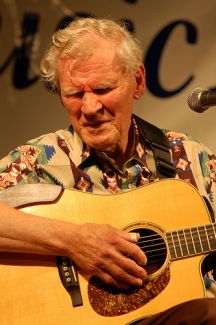Part i: Introduction; Part ii: Ballads and Balladists of North Carolina; Part iii: People and Trends in North Carolina Folk Music; Part iv: References
See also: "Ballad of Tom Dooley"; Mountain Dance and Folk Festival; Southern Folklife Collection.

North Carolina boasts a strong tradition of folk music dating from the beginnings of settlement to the present day. Folk songs are transmitted primarily through oral and informal means among singers of a given community, with each singer often putting his or her own stamp on the material so that one song usually exists in a number of variant forms. The English scholar and folklorist Cecil Sharp defined a folk song as having been "created by the common people" rather than by the "educated." Sharp theorized an evolution of folk music turning on three factors: continuity, variation, and selection.
Folk songs address every aspect of life. Many ponder personal relationships or express an individual's emotions. Songs of courtship and love as well as the blues fall into this category. Other folk songs convey an individual's relationship with the community and perhaps remark on work or local features, places, or figures. Folk songs also include topics of national significance. In North Carolina, major political and military conflicts such as the Regulator Movement, Revolutionary War, and Civil War inspired folk songs that circulated until at least the beginning of the twentieth century.
Not all folk songs look outward to the world of human endeavors and relationships, however. Many religious songs and hymns are folk songs. In addition, many folk songs are functional in nature, their music and words used for practical purposes. Tunes played for dancing often have many accompanying verses. If instruments are scarce, these tunes can be used alone for dancing. Likewise, some songs, known as "play-party" songs, are associated with particular games, and most lullabies circulate as folk songs. Work songs pace manual labor or pass the time during repetitious tasks. Scholars often consider hollers, wordless but usually tuneful shouts used to communicate across great distances, and auctioneer's chants as quasi-folk songs.